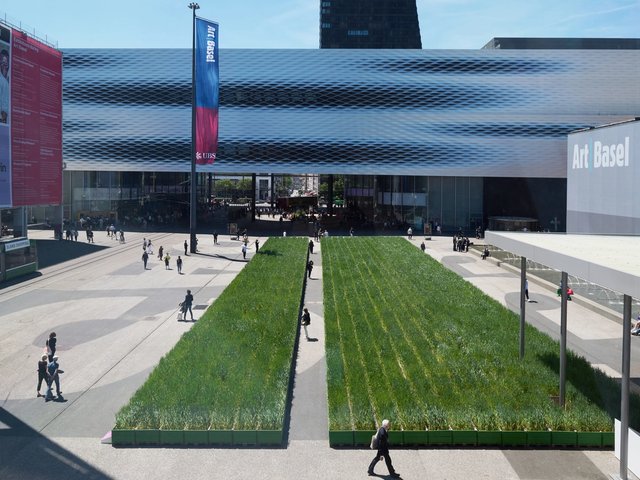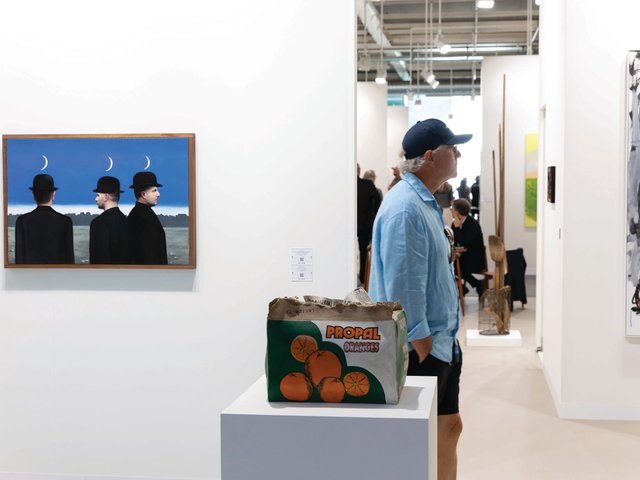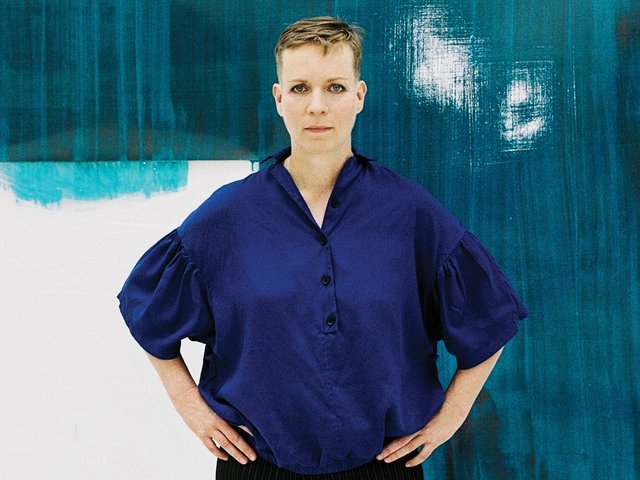Visitors at Art Basel this year will find it impossible to ignore Katharina Grosse’s commission for the Messeplatz outside the fair. CHOIR (2025) is the latest in Grosse’s enveloping painted environments; it covers the entire square and Messe building in the artist’s customary veils and fields of high colour, made with her spray gun. Though they are composed of these vast colour planes, for Grosse—who was born in Freiburg, Germany, in 1961 and lives in Berlin—the paintings are not abstract. As she told The Art Newspaper as she prepared to make the work in Basel, her work is formed from “thought processes that trigger a relationship to the physicality of the world that is then made very theatrical”. As such it strongly relates to, and often directly incorporates, architecture.

A mirrored ceiling reflects Grosse’s installation CHOIR in the Messeplatz outside Art Basel Photo: Jens Ziehe; courtesy the artist; © VG Bild-Kunst, Bonn 2025
Key to the power of Grosse’s work in general, and specifically CHOIR, is her use of an almost indefinable scale, which she describes as “liberating”. As she says: “It’s almost as if you’re within a surface where you can’t say, ‘This is this big, this is as big as my car.’ It is as big as a certain form of imagination. And imagination doesn’t have a scale.” It is a busy summer in Europe for Grosse; in addition to the Art Basel commission, she has exhibitions at the Deichtorhallen in Hamburg and the Staatsgalerie Stuttgart.
The Art Newspaper: The Messeplatz is a huge space. How have you tackled it?
Katharina Grosse: The special thing about the Messeplatz is that you enter the square without any kind of preliminary experience: you don’t walk through a park and see it far away; you’re suddenly in it. There is no moment of negotiating. And that is so interesting. You’re right away in a situation of all these different buildings—the fair being one of the most important fairs for contemporary art in the world, with so many visitors. And it’s almost a competition for attention. A painter has never done anything this big in urban space and inserted it into a very busy situation for seven days. The very specific thing I’m doing is painting over the whole square—over the roofs, the façade—as if a huge painting is passing through, almost ignoring that people will walk on it, talk on it and be almost in it all the time.
Have you been told you can pretty much do whatever you want in terms of that space? Because if you are going to envelop the viewer, you need to do it fully or it does not work, right?
It’s so true. The painting is formulating its ignorance almost. It’s going through the water—there is this big fountain—and it will jeopardise the functionality of the clock. It will touch upon all these different elements that make up that scenario and turn it into a situation where you almost have the feeling that I’m painting my way out of the fair, into the street, over the tram lines and so on.
To what extent can you plan or improvise in those circumstances in response to the environment—to light, weather conditions and so on?
The special condition is that when I paint on site, I have to intertwine myself and the work with the existing conditions. And they have to be part of it as well, because they are undeniably there. What I’m looking at is how I can change a situation that I don’t erase, but that I work with. It’s almost like a game. I’m playing with all these factors. But at the same time, I do minimise and simplify the elements I bring in, because the situation is so complex. I’m using one or two different tones of red—magenta, to be completely precise—and white so as to give it an underpainting that makes the colours luminous and brilliant. And my tool is very simple: it is a spray gun, which lets me reach far, which makes my work fast and my actions unlimited, mostly. I can swirl and walk and run around and find my way. The painting itself is developed on site across almost seven days.
You talk about running, about swirling—about body movement. You have also talked about bodily intelligence. On the one hand it is about your own bodily intelligence, but it is also calling on the audience’s, right? You are asking us to act with our bodies.
Yes, exactly. It is almost an invitation to use all your amazing abilities, each cell in your body, to take it in and react to it. Because every cell in our bodies is changing every second that we are alive. So, the work is almost like a call for appreciating this very heightened form of being alive, of being aware, of being in an urgent, very much in-the-moment situation.
The Messeplatz work is almost like a call for appreciating this very heightened form of being alive, of being aware
What suggestions are you making to your audience in terms of content and their imaginations? How do you employ the imagination of the visitor when you are making your work?
First of all, you experience a confrontation of a painting being slipped into a situation where you don’t expect it and where it’s normally not at home. It is almost a fragile watercolour in hostile circumstances. And the collision does something to you. It alerts you to the fact that you’re all running through that square, everybody coming from all over the world with very different agendas, being very individual, looking for individual things that you want to encounter in the fair. And yet you coexist on that surface of the work. You uniquely experience something where you understand that the conditions are coming from all sorts of different perspectives. And that unscripted togetherness has a lot of unforeseen elements, yet you have a sensation of unification, which is almost a paradox; we are together even though we are not, even though we pay a lot of money to show how different we are. I think that is the starting point for negotiating with one another and maybe with agreeing on certain things we all share. That’s the open-ended offer.
In your show at Hamburg’s Deichtorhallen, and also The Sprayed Dear exhibition in Stuttgart, your sculpture is at the fore—both in terms of your historic work and your contemporary work. Did you want to foreground that element or is it a happy coincidence?
It is almost a happy coincidence that I have the possibility to show the whole range in a single moment this year. The Stuttgart exhibition shows the multidimensionality of the work that’s not yet sculptural, really, but that has all these different perspectives of materiality, of visceral impact on your ability to digest visual forms. And yet it also shows very early works that I did when I was still a student. Even as a kid, I was painting on all sorts of surfaces—my dad’s writing desk or the garage doors. I was very organically taking for granted that I have that space to act in the world, to do something with the world. Painting for me is an ideal medium to be so direct, and it does connect us to the oldest forms of art, like a handprint in a stone cave—even that’s “spray painted”. That very archaic first response to how you see something and digest it and make something out of it comes into these shows. In the Deichtorhallen show, there is a very large work that has to do with the expansion of the framed canvas and how working in a larger field shows everything you think, and that doesn’t exclude things that you think have gone wrong. I’m looking at what is “right” and “wrong” in a very different way.
• Art Basel Messeplatz Project 2025: Katharina Grosse, Basel, until 22 June; Katharina Grosse: Wunderbild, Deichtorhallen, Hamburg, until 14 September; Katharina Grosse: The Sprayed Dear, Staatsgalerie Stuttgart, until 11 January 2026





